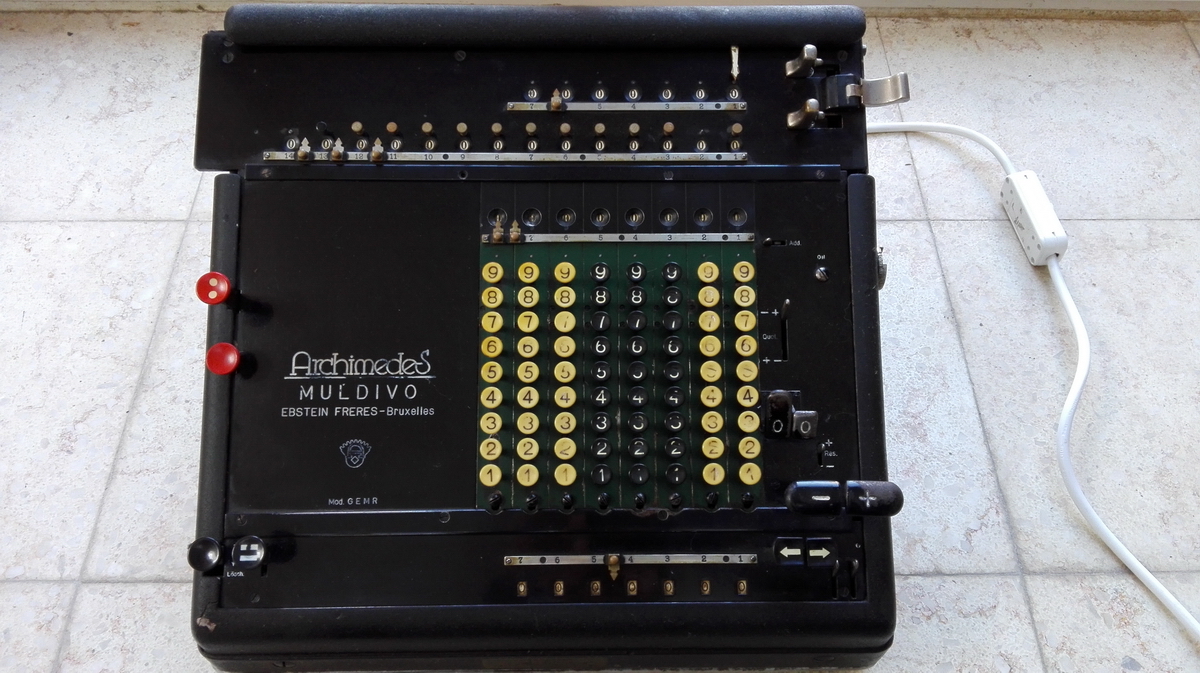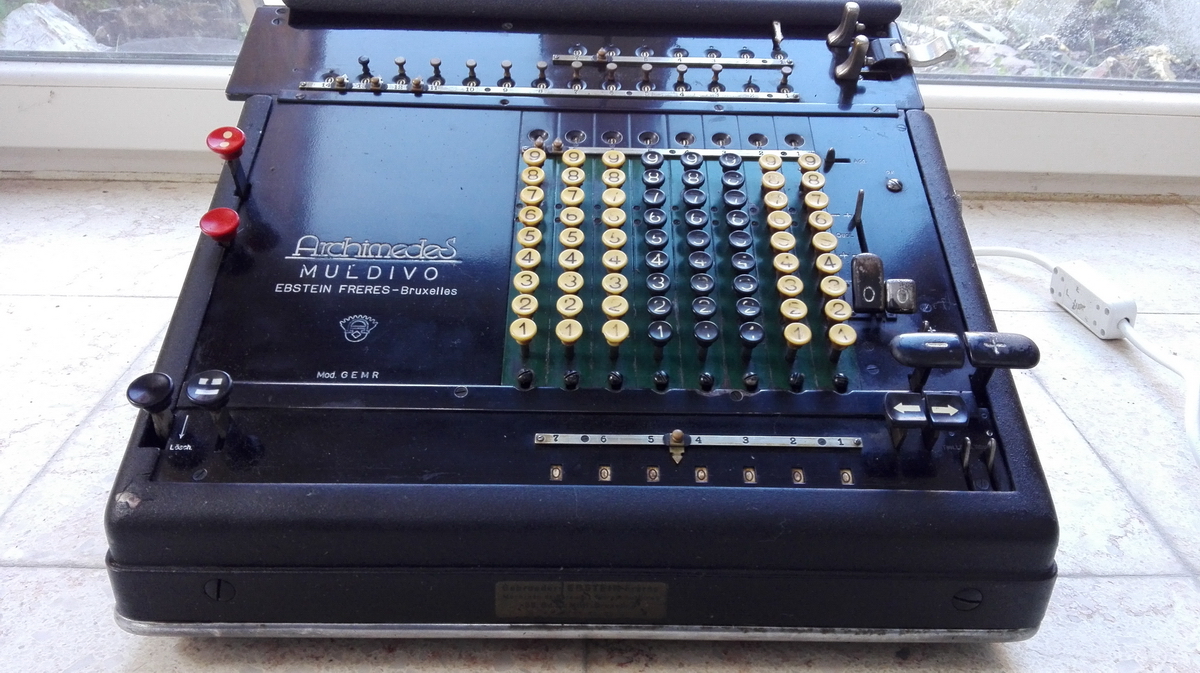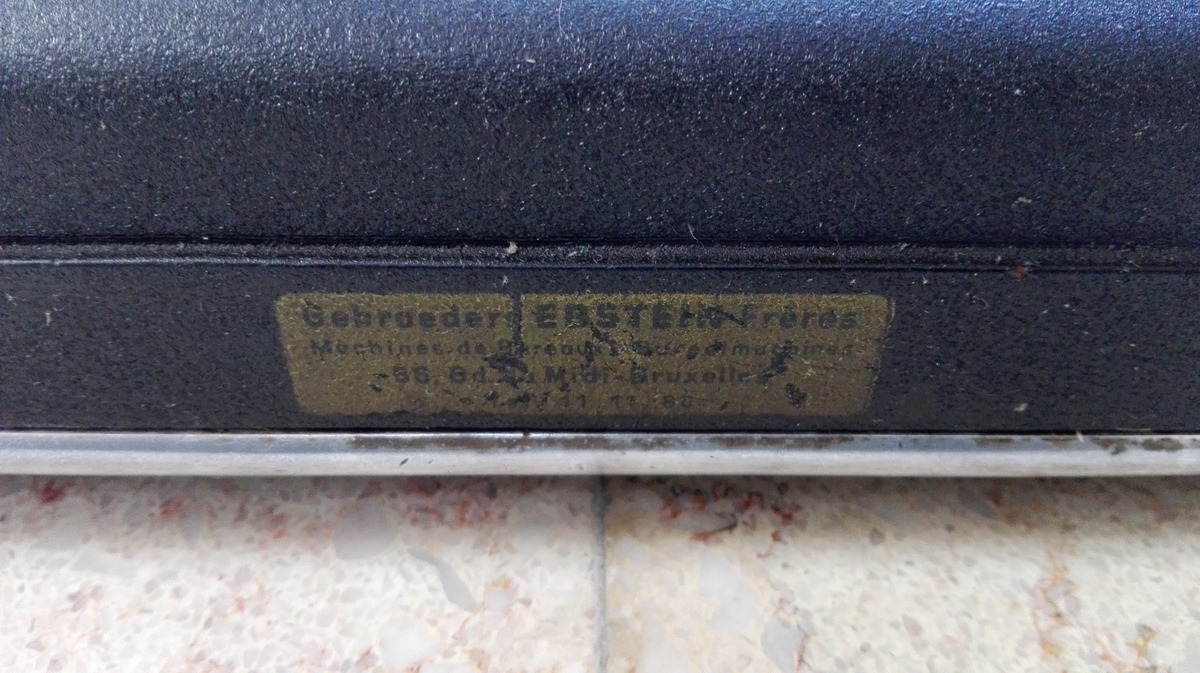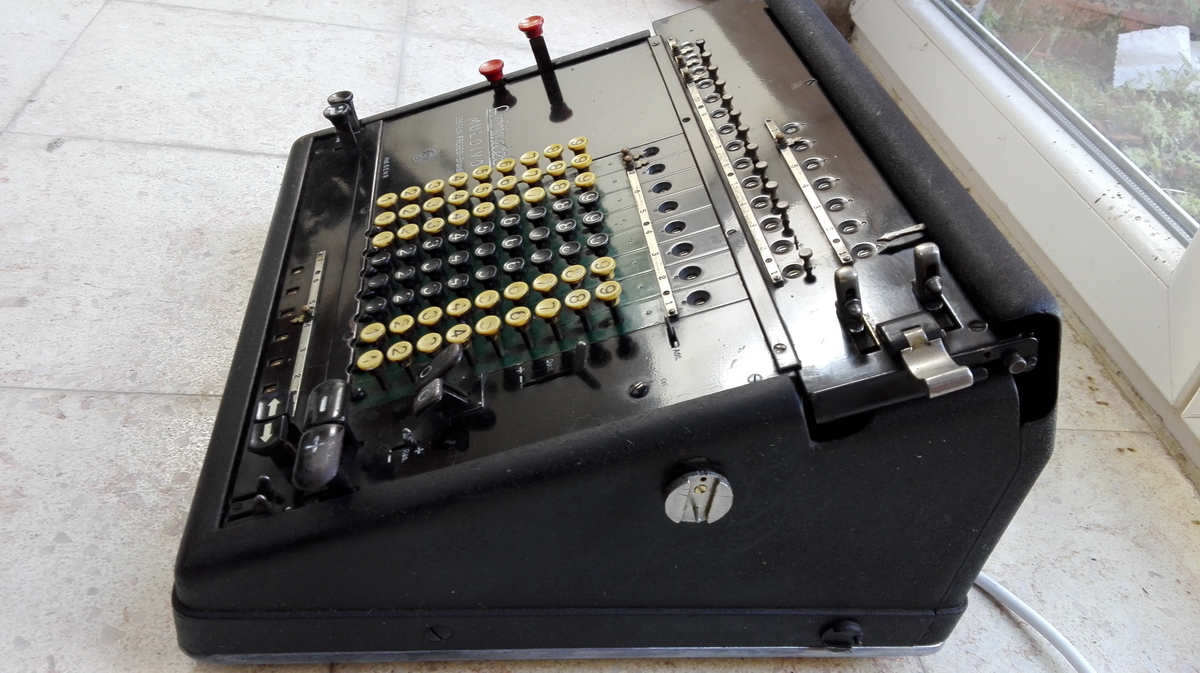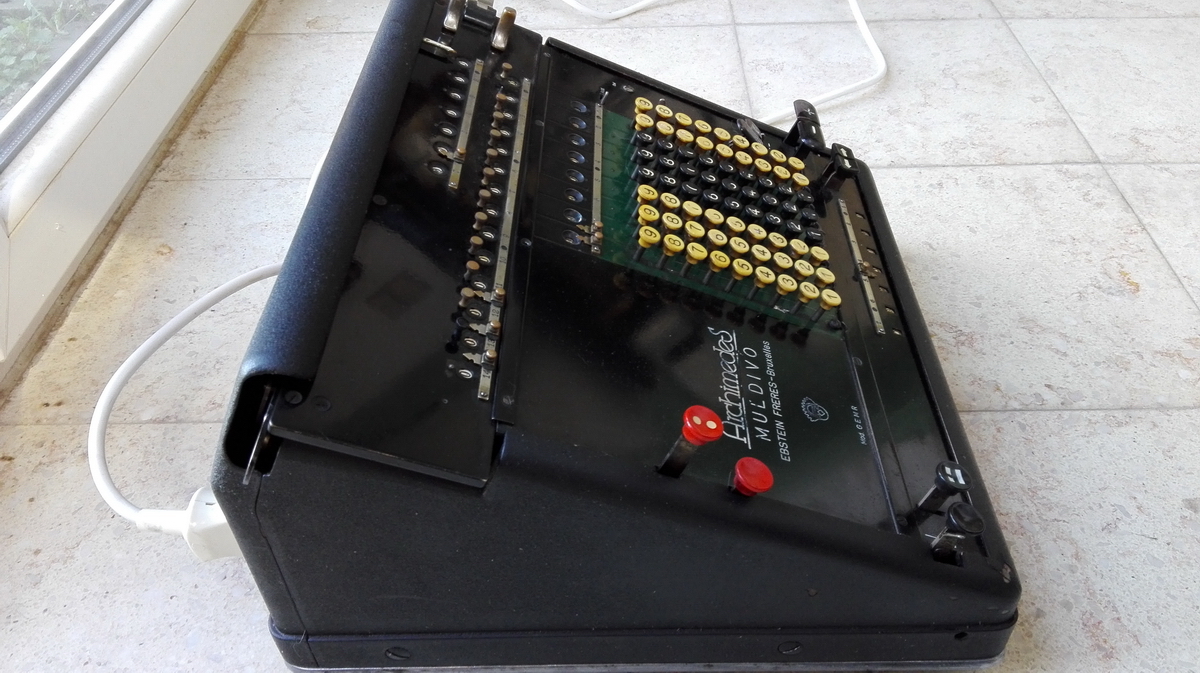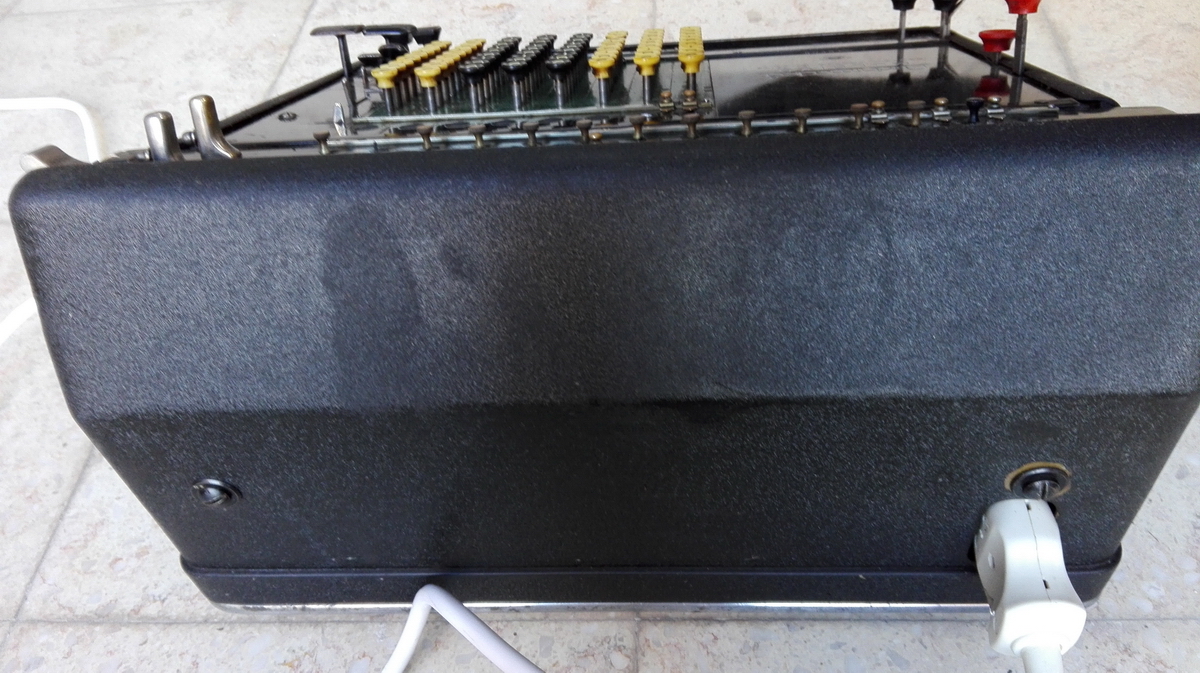Archimedes GEMR
Not exactly the typical calculator in my collection, because it is quite late (1932-1937), it is electric, automatic, and in addition it is not really in my collection.The reason for this is quite simple. It used to be the machine that belonged to a firm that sold timber in East-Flanders. In the mid seventies it was banished to the owners' children's attic, where it suffered a roof replacement, including being in the spray of a pressure washer, and finally was dug out by the firm's owners' grandson, now in his mid-40s. His daughter took a liking to the rather horrible looking machine that had belonged to her great-grandmother, and neither of them being very technically oriented, they decided to put it up on a second hand website, for sale. The machine is not really my piece of cake, but being quite early for being fully automated, I thought it would be a nice challenge, and I do like Archimedes machines in any case, so I left a bid. The seller came back with a counter offer of 250 EUR, which is rather a lot for a machine in unknown condition that is, however, definitely blocked. I told him so. Then he told me that they were actually not really looking to sell the machine, but to find out more about it, and did I possibly know someone who could repair it? Well, I happen to dabble in that department, so I told them to drop it off, and that I would take a look.
Fast forward to a couple of weeks later. They arrive, father, daughter in tow, and the machine in the trunk. It was absolutely filthy (thanks, pressure washer and roof replacement) and completely and utterly blocked. I thought it was stuck in a division cycle, but that did not explain why nothing at all moved. I told them I would need a bit of time to look at it. The keyboard was free, and could be used to enter numbers and clear - pretty much everything else had the disheartening feel of being subject to a mechanical interlock.
So I tried to take the back and carriage off and prodded around. Something I did made the machine free up partially, and I could now turn the manual knob on the right side of the machine, and make it do some operations - the add and subtract knobs, however, were still stuck, and so were the direction changing levers. The carriage movement would sometimes work by turning the machine by hand.
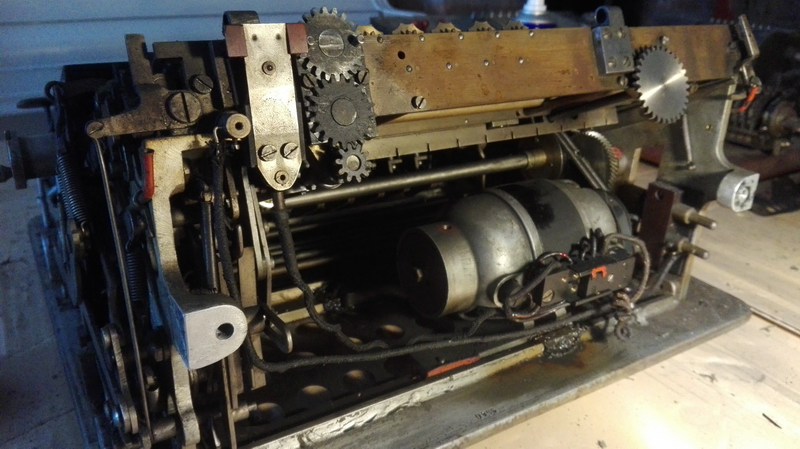
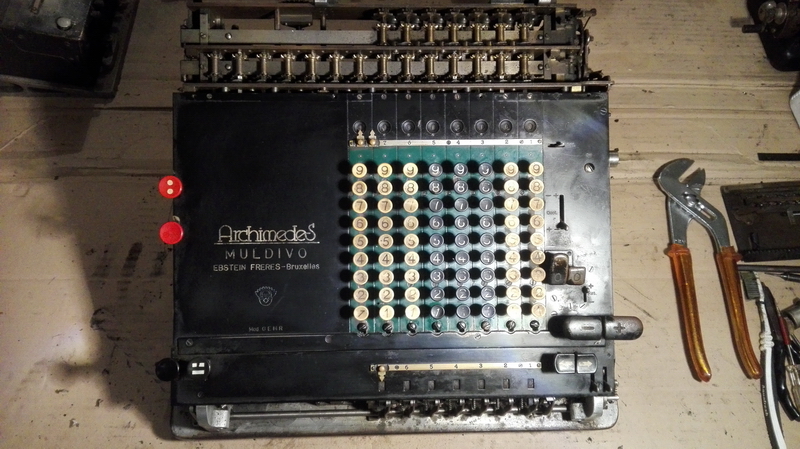
I quickly checked the motor over, there seemed to be no bare wires touching the frame, the machine was set to 220V, and there were no shorts in the motor, so I took the chance to power it on. As soon as the plug was inserted, the motor started spinning, and the contacts burned off the decades of filth (yay, smoke and sparks!), but the machine did not turn along with the motor (the motor is connected to the rest of the gear train by two steel spring bands). I unplugged it and started looking what the problem was. Taking the enclosure off also implied taking the hand knob off. It then transpired that the knob was actually loose on the shaft, because someone at some point had forced it to the point that both the screw and the locating pin had been broken off. I dismounted the motor, took it apart and cleaned and lubricated it. The motor contact was firmly closed by the mechanism, so it was clear that the machine was doing something. But why didn't it spin with the motor powered on ?
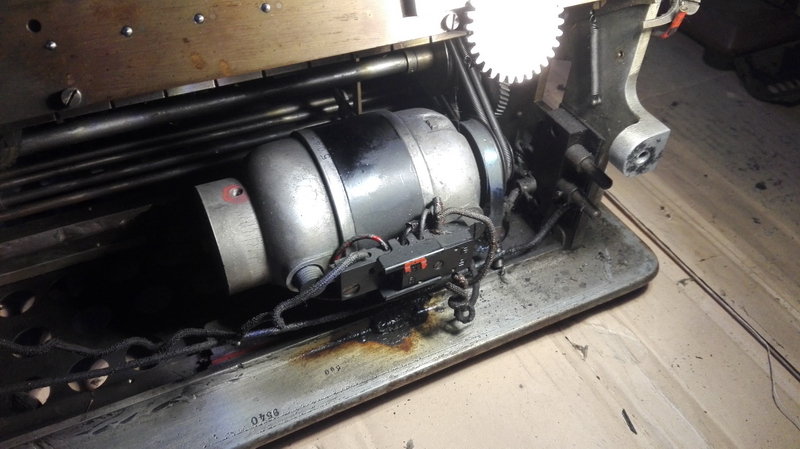
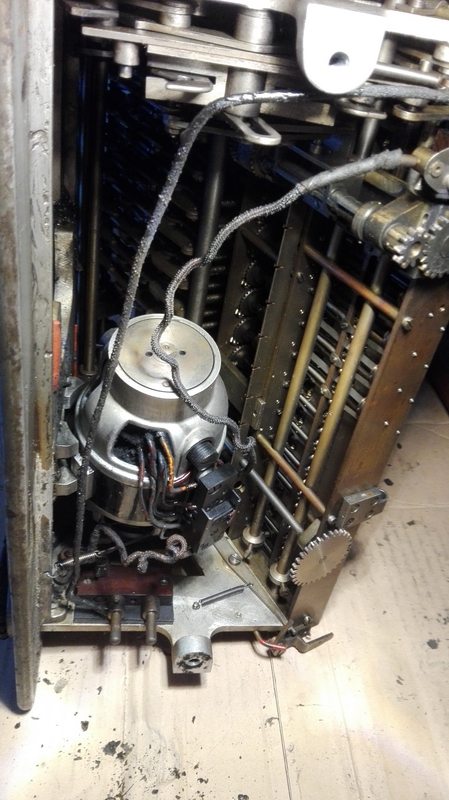
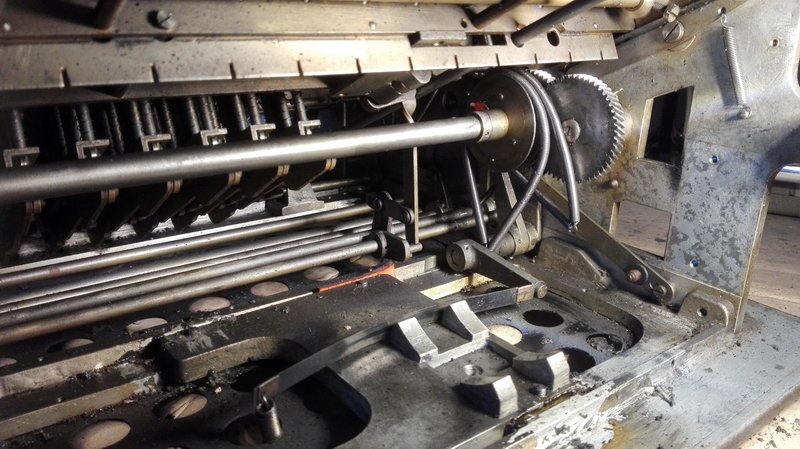
Looking further, the blockage seemed to be in the transmission to bring the motor speed down to 400rpm for the machine. The intermediate gears were completely stuck onto their shaft, despite lubrication. It took some judicious application of force on the gears to get them to start to move. Once there was movement, oil could get in, and it went progressively better from there on. I remounted the cleaned motor and plugged it in. Now the motor turned the machine .... in an endless loop, never stopping, with all of the other functions still blocked.
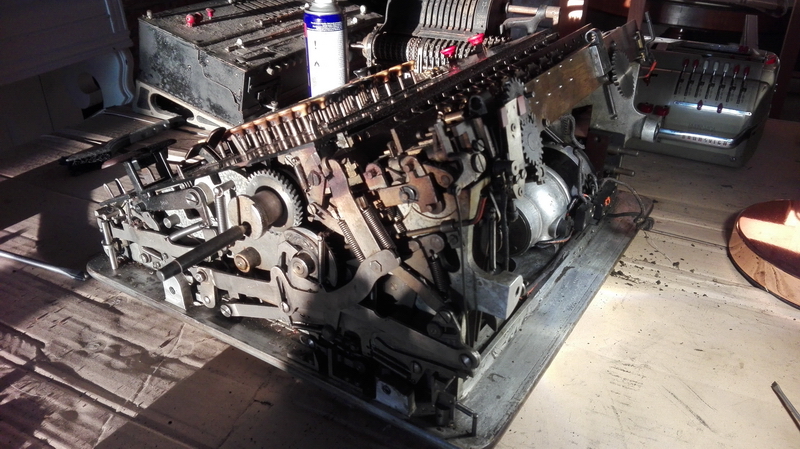
I kept prodding at various parts of the mechanism to find where the issue was, every time running the motor briefly to see whether the machine would stop. Doing something to the keyboard clearing mechanism for the automatic multiplication and running the motor caused the machine to run three cycles, and with an almighty "clunk", the division knob jumped about two centimeters upwards from its previous position - and the motor stopped. I sat in sudden silence, suspiciously eyeing the machine. All +/- levers could now be moved effortlessly. The keyboard still worked. The left-right buttons for the carriage worked, causing a single revolution of the machine while trying to move the dismounted carriage. The plus/minus buttons worked, running the motor as long as they were pressed - it really seemed that the machine had reverted to its normal working condition. I quickly put the filthy carriage back on and started to explore the functions of the machine.
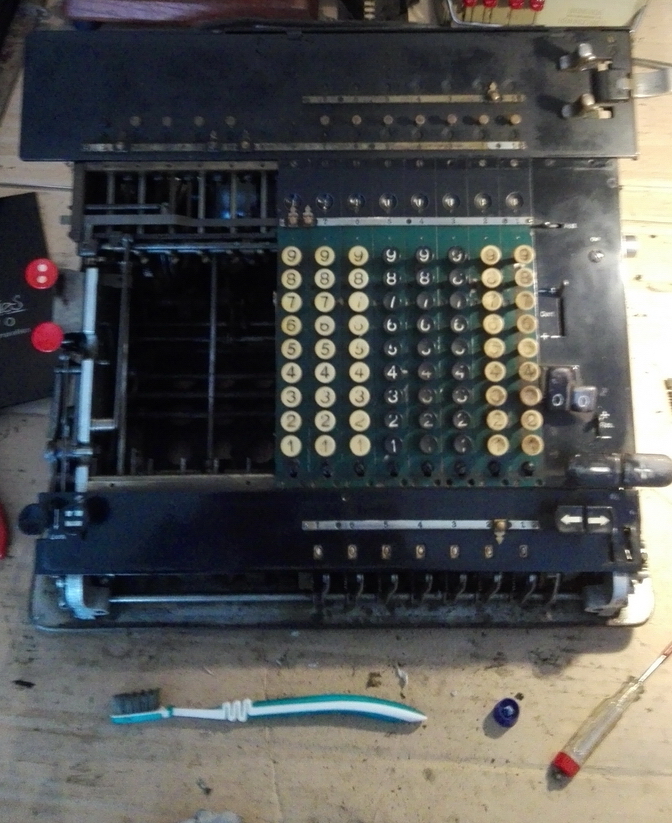
I immediately blocked it again by trying to move the carriage to the right - the readout mechanism for the multiplier needs to be precisely positioned, and it does so by coupling a gear to a rack at the back of the carriage (more about that later). If the gear is misaligned, after some tens of degrees of rotation, the readout mechanism will block the machine.
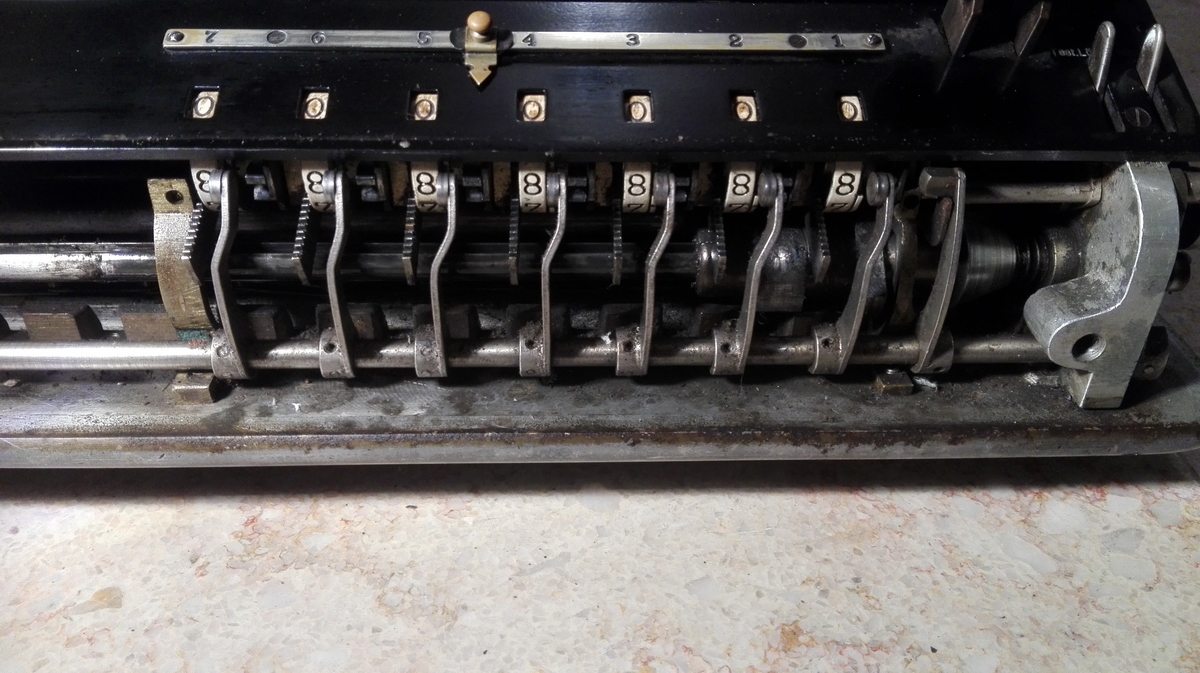
That was quickly rectified, and now the machine would accept numbers in the keyboard, and sum them into the result register. The small lever "Add" at the top right of the keyboard clears the keyboard at the end of the first cycle, so that machine can be used as an adding machine. The large "0" button clears the keyboard, the small zero button runs the carriage to its home position and then clears both registers, if the buttons on the manual clearing levers are in their downwards position. Cool! The direction levers are a bit strange to get your head round, because they work together. The large direction lever "Quot" gives the direction of the revolution counter, and the markings next to it give the effect the large + / - buttons will have for the revolution counter register - if the lever is up, +/- counts +/- revolutions, if the lever is down, the + button counts negatively in the revolution counter, and the - button counts positive. Then there is the small "Res." lever, which only serves for automatic multiplications (again, more about that later). It can make the revolution counter count in complements during a multiplication, and is only active during automatic multiplication - while it can be set to "-" in addition/subtraction mode, it is immediately overruled automatically by the +/- buttons, and switched back to "+".
Now, the automatic functions. According to the fantastic book "Archimedes, Die Geschichte einer Rechenmaschinenfabrik in Glashütte/Sachsen" by Schmid, Eichler and Hänsgen, two of which have been instrumental in the development of Archimedes machines, and write about their experiences (from the grave) decades after the fact, the model G was the machine that catapulted Archimedes back into the front line of calculator development after the competition developed slide carriages, which the Archimedes didn't have, real electric machines with inboard motors, and automatic functions. It was developed very quickly, from experimental machines that had been built under the directorship of Reinhold Pöthig, but never further developed for actual production . Ulrich Eichler, Pöthig's brand-new son in law, quickly had the new model G with slide carriage developed into production, after they were told in no uncertain terms by Hans Sabielny, their sole distributor, that he could no longer sell their machines if they didn't come up with something better than the antiquated machines they were currently producing. The E in GEMR stands for Electric, M is the automatic Multiplication and R is "Rücklauf", automatic carriage movement.
So let's start with multiplication. The genius of Archimedes machines of this vintage is that both multiplicand and multiplier can be entered on the same keyboard, with various options as to what is retained after the operation. Most (well, all) other machines with automatic multiplication would have a separate small keyboard for the multiplier.
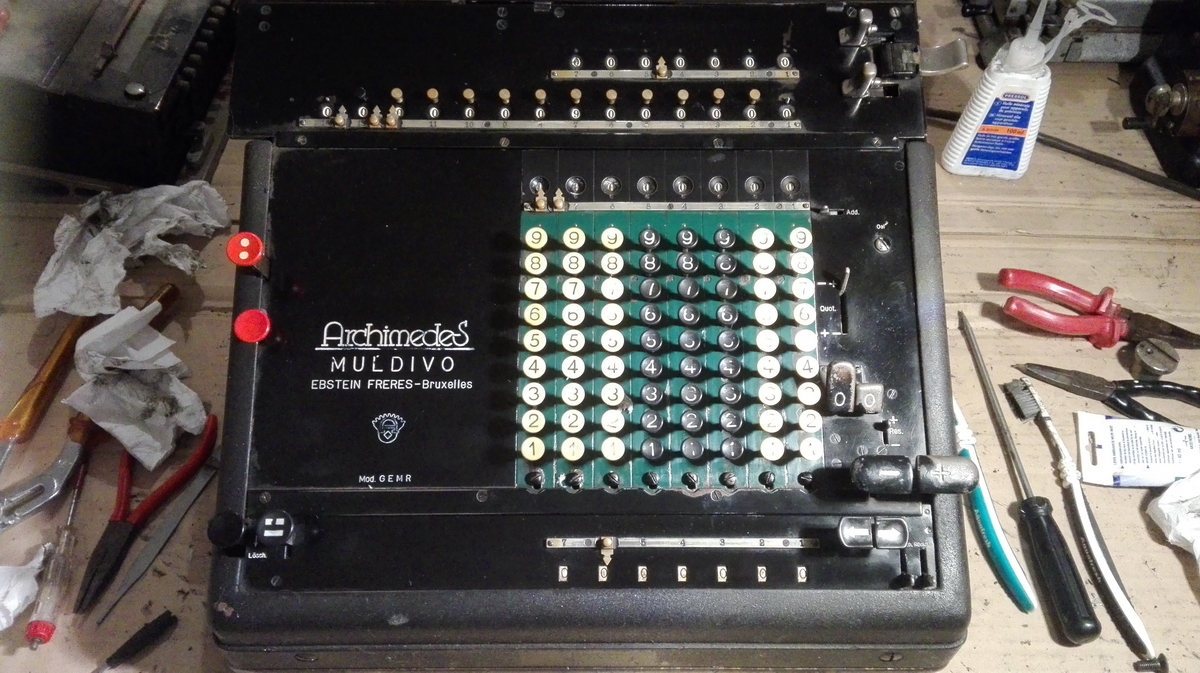
The way this works is like this: key in the multiplicand in the keyboard. Press the black multiplication button (x) in the lower left corner. This decouples the keyboard from the setting register, and, depending on the lever next to the black button (when set to "Lösch."), also immediately clears the carriage and runs it back to the rest position. It also clears the keyboard (but not the setting register!) and now connects it to the multiplication register at the bottom. Anything typed into the keyboard now goes directly into the multiplication register. Then you press the "=" key, which will start the machine, and run through the multiplication register from right to left, until only zeroes are left, and the number entered has been transferred to the revolution counter (or its complement, depending on the settings of the machine). The two small levers at the bottom right can also be very useful depending on what you want to do - the left one is "Tast. Lösch." which does exactly that - when in the "up" position, it will clear the setting register at the end of the calculation. If it is down, the setting register remains with the multiplicand that was set earlier, to be reused for a next multiplication. You just press "x" and key in a new multiplier. The other lever "Rückl.", runs the carriage back to the setting position after the multiplication is done (but does not, of course, immediately clear the result). The "Res." selection lever can now be used to do negative multiplication by making the result register count in complements, while the "Quot." lever keeps its normal way of operation, reversing the direction of the counter register when downwards.
Automatic division works along the same lines, but of course without using the multiplication register. You run the carriage all the way to the right, key in the dividend on the lefthand side of the keyboard, and push the "+" button to transfer it to the result register. Now clear the "1" out of the revolution/quotient register and type the divisor into the keyboard, also on the lefthand side. All that is now left to do is to press the large red ":" key, and the machine will automatically divide the result register by the number in the keyboard, until it runs out of carriage positions and quotient digits, then it stops. The remainder is in the result register. The machine does not, however, use abbreviated operations, neither in division, nor in multiplication. The division algorithm implemented is to subtract until the result overflows, then add the divisor once and then shift the carriage left one position.
If anything goes wrong with either automatic multiplication or division, the red button below the ":" button will stop the operation and (hopefully) return the machine to its home position, after which the registers can be cleared and operation resumed.
Here's a video of all the automatic operations:
The carriage was now dismantled and cleaned, which returned the numbers to their white colour (they found a process to enamel the counter wheels white - in earlier Archimedes machines, the numeral dials are bright nickel).
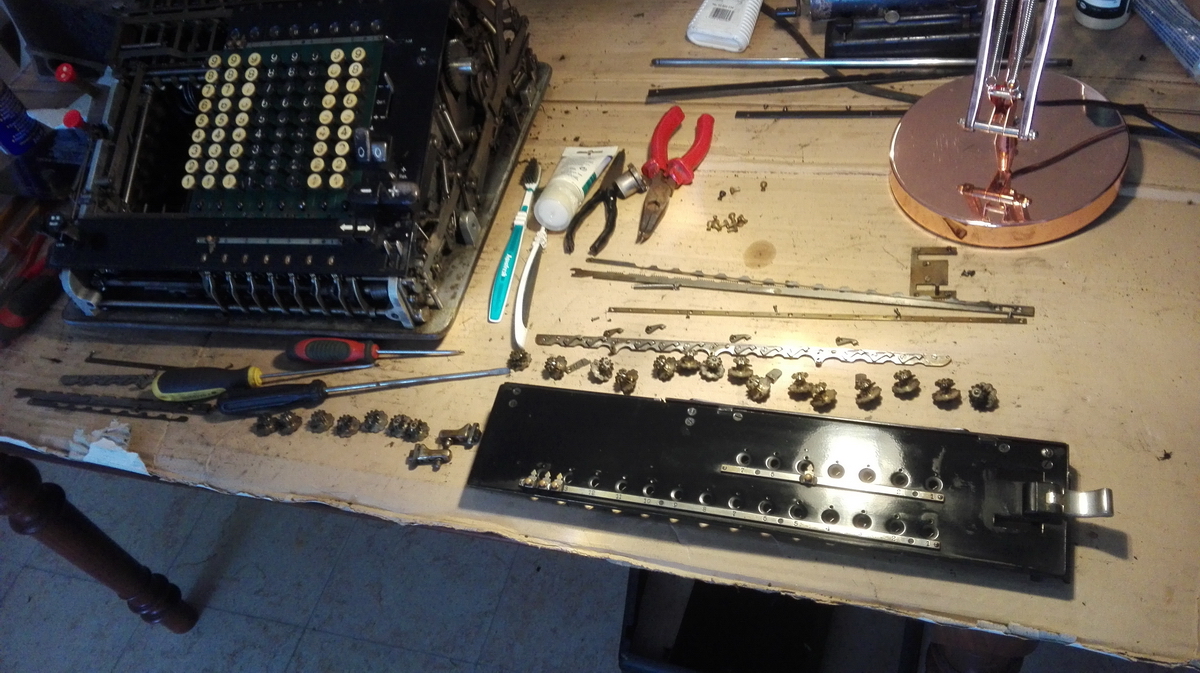
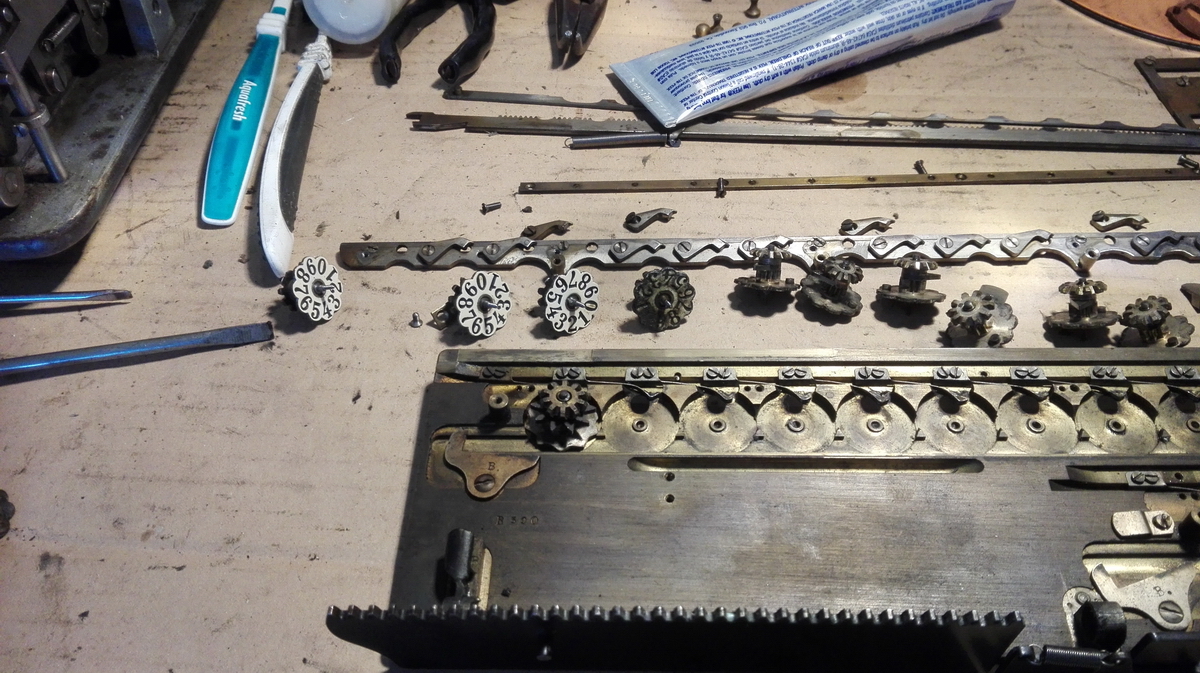
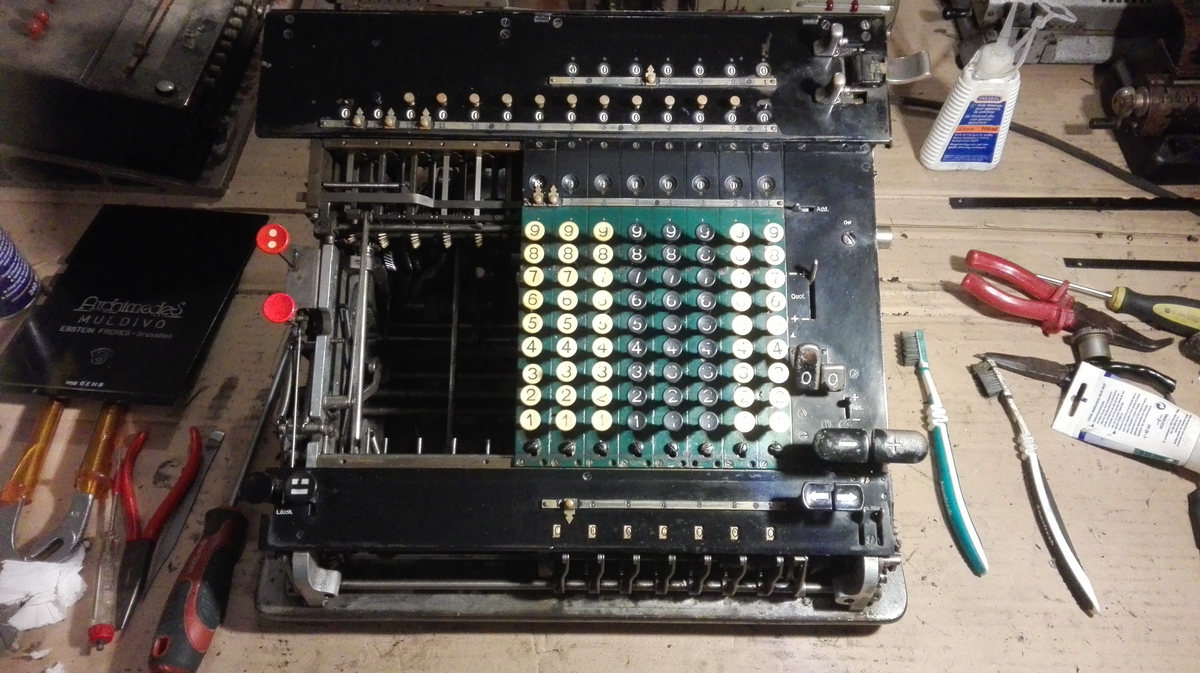
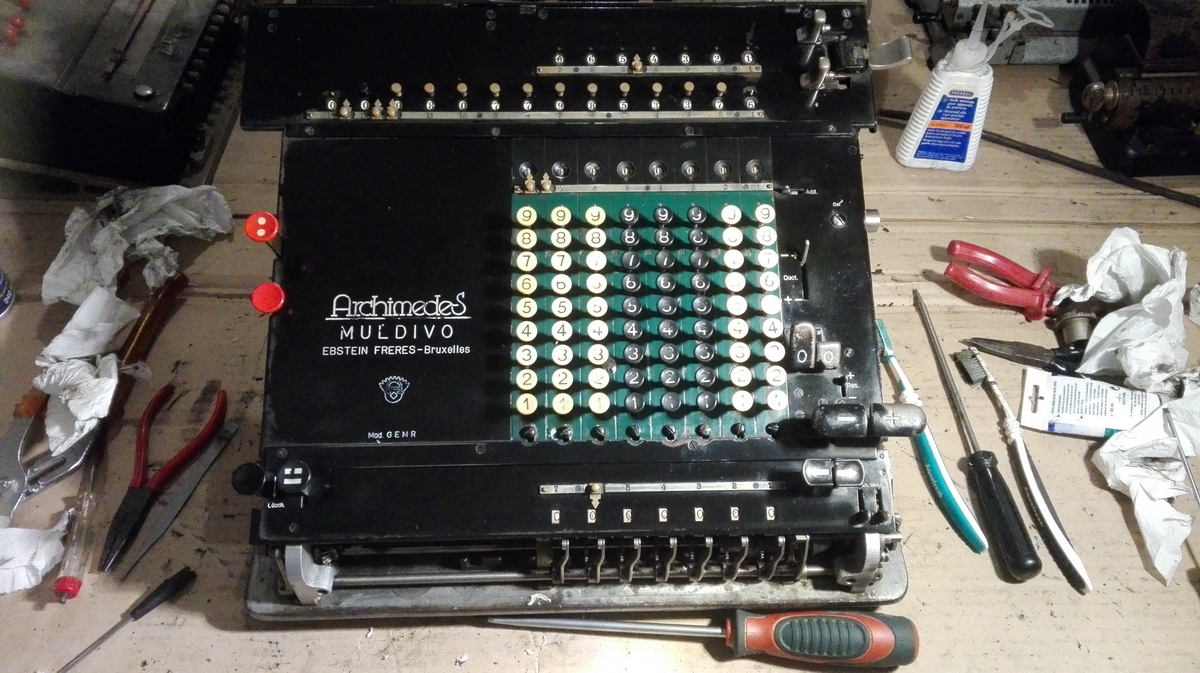
The clearing handles are a bit special in the electric machines, because they incorporate a button which shifts a kind of hook downwards out of the button, to be grabbed by the electric clearing mechanism. If the button is up, so is the hook, and the register can only be cleared by hand.
After reassembly and mounting, all that needed to happen next was to replace the wiring with its cracking insulation, remount the enclosure and drill out the broken screw in the stub for the manual crank.
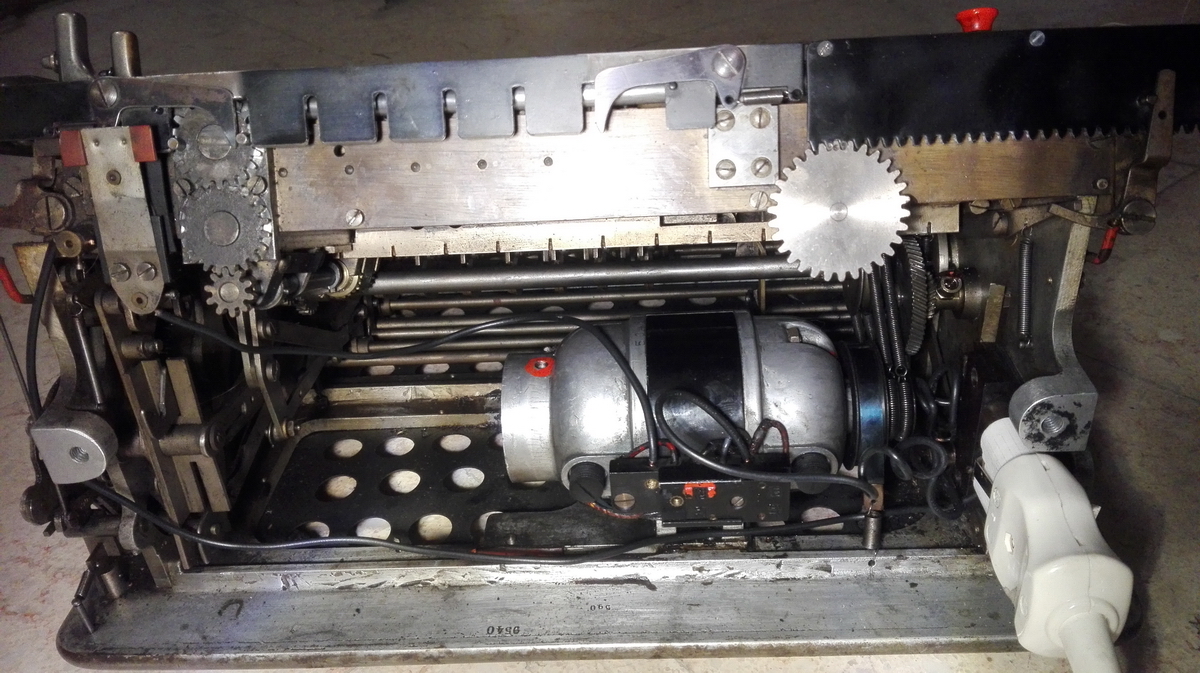
I also decided to earth the machine to make it safer to operate. Luckily (well, miraculously!) it was possible to find, 80 years after the fact, a precise fit for the plug, with a ground connection incorporated! All that needed to be done was to add a piece of metal to the frame that would contact the earth on the plug. Easy as pie!
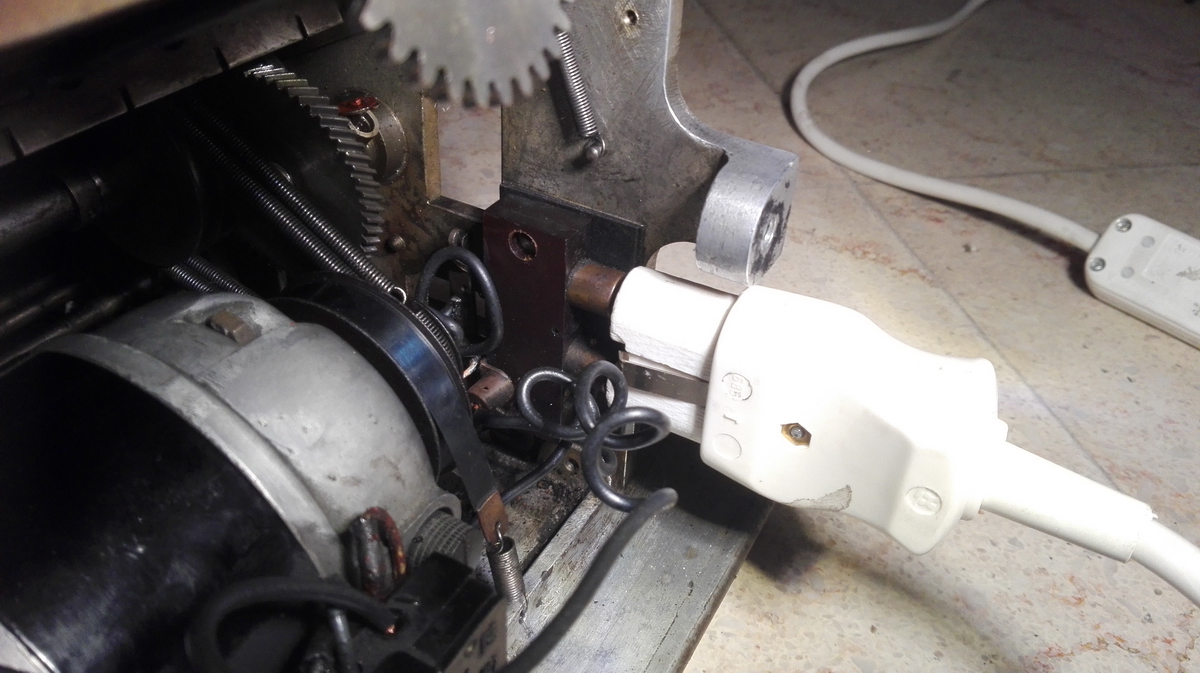
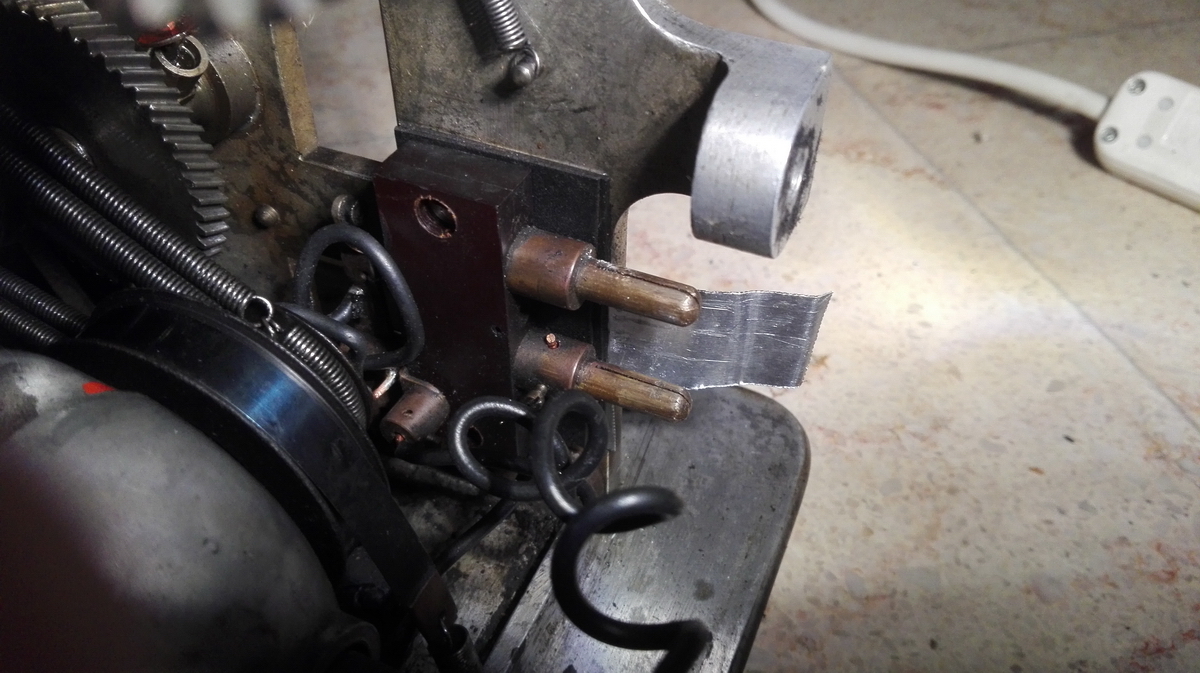
I also added a suppression capacitor, to reduce sparking at the contacts. Finally, the machine was rewired, passed all of my testing, and it can now stand up to another 80 years of (probably light) use. Some views of the internals:
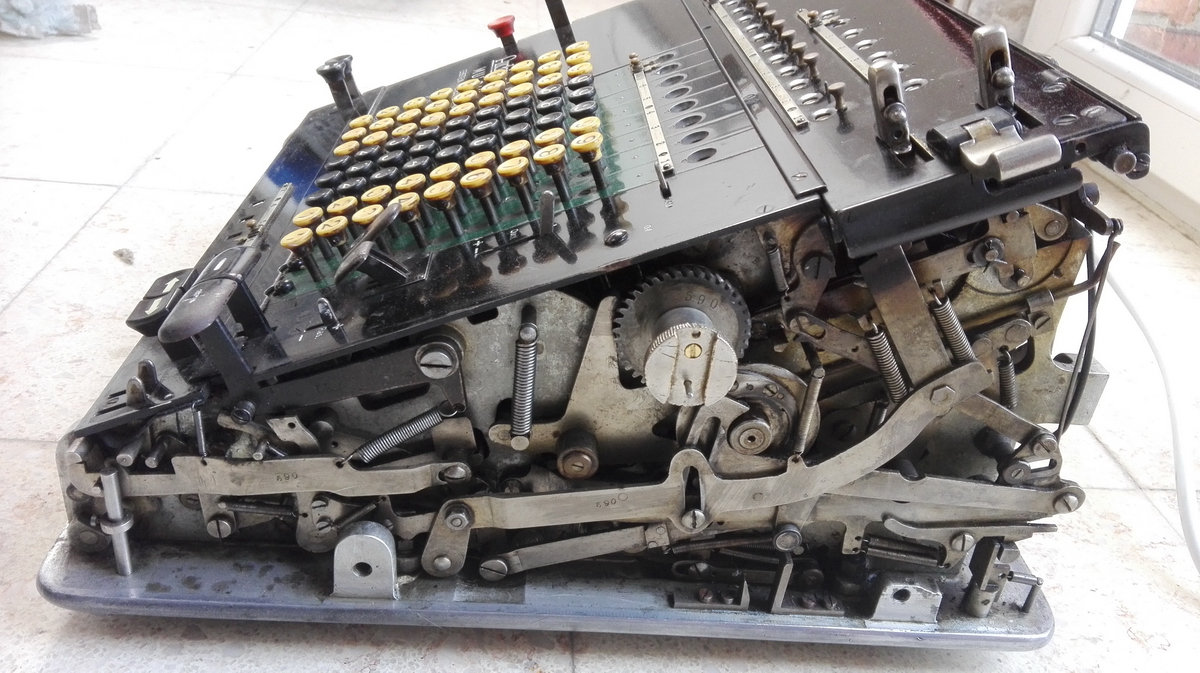
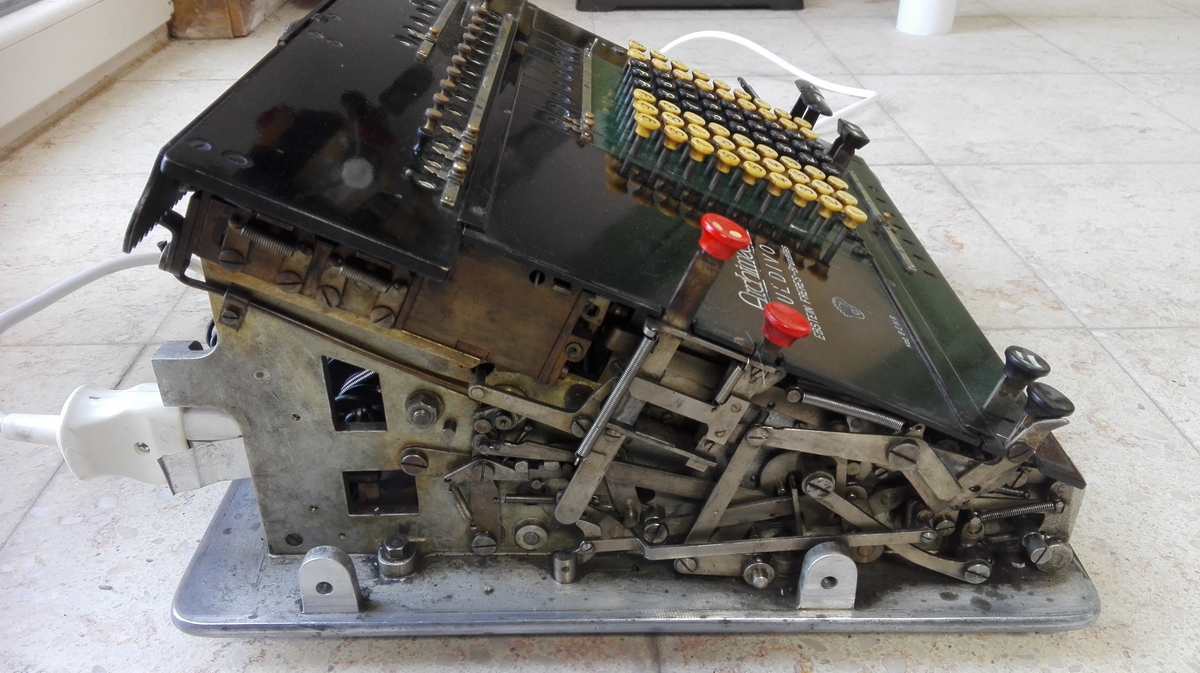
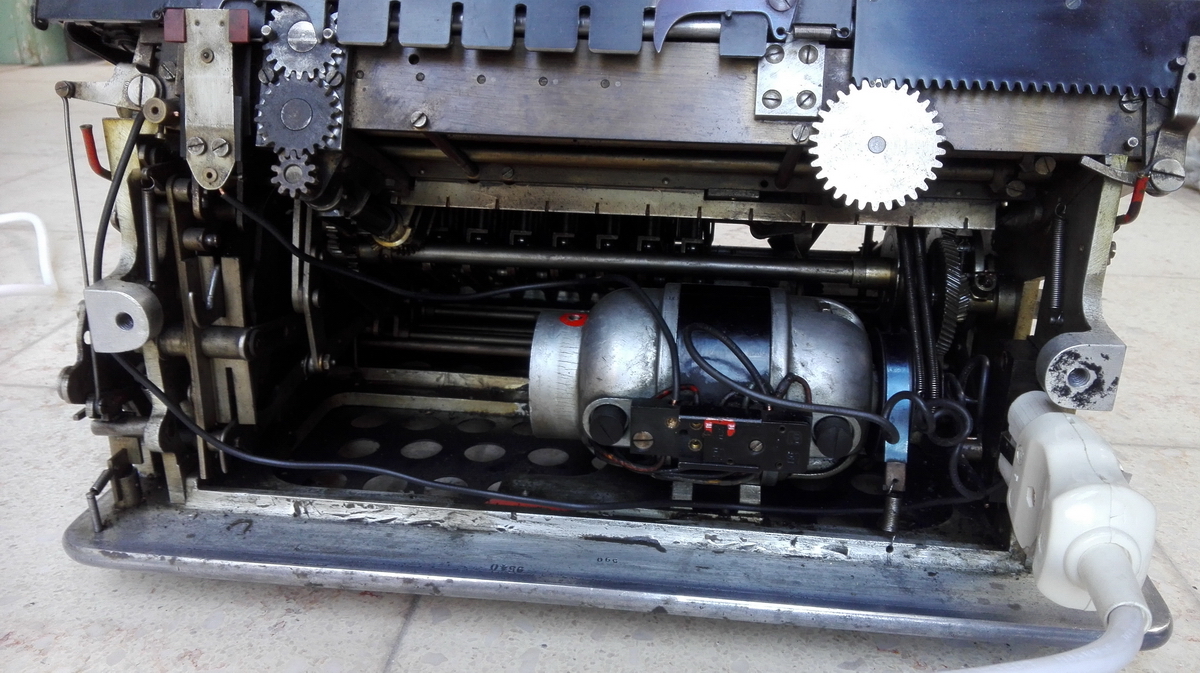
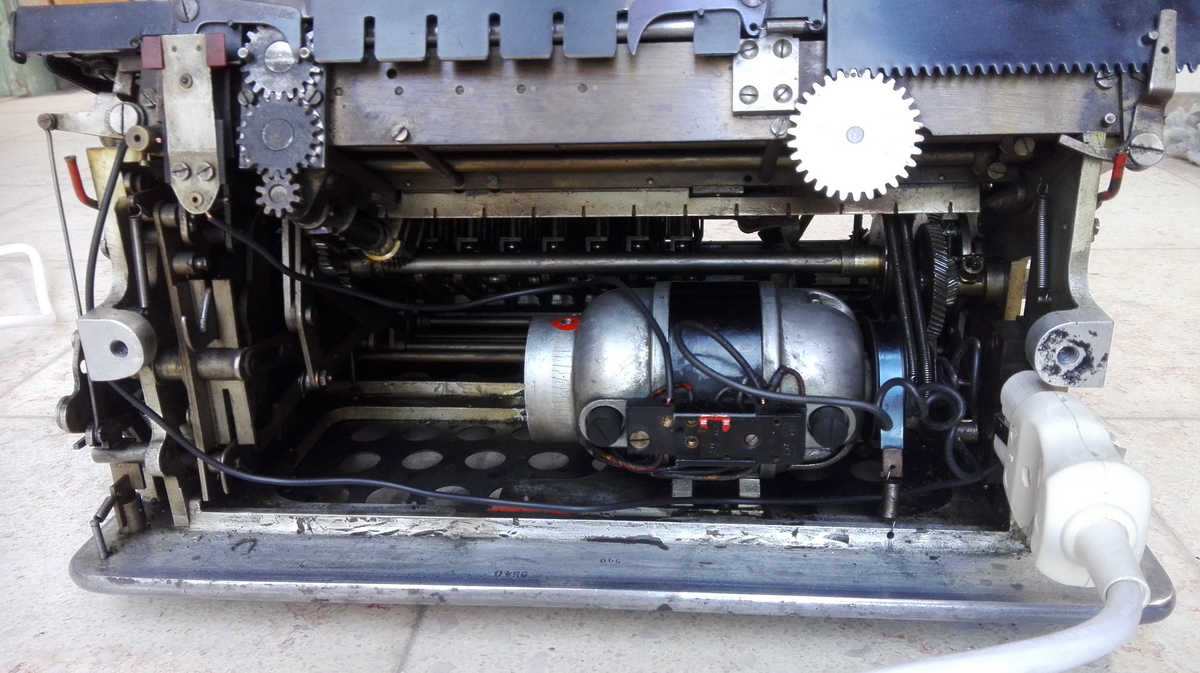
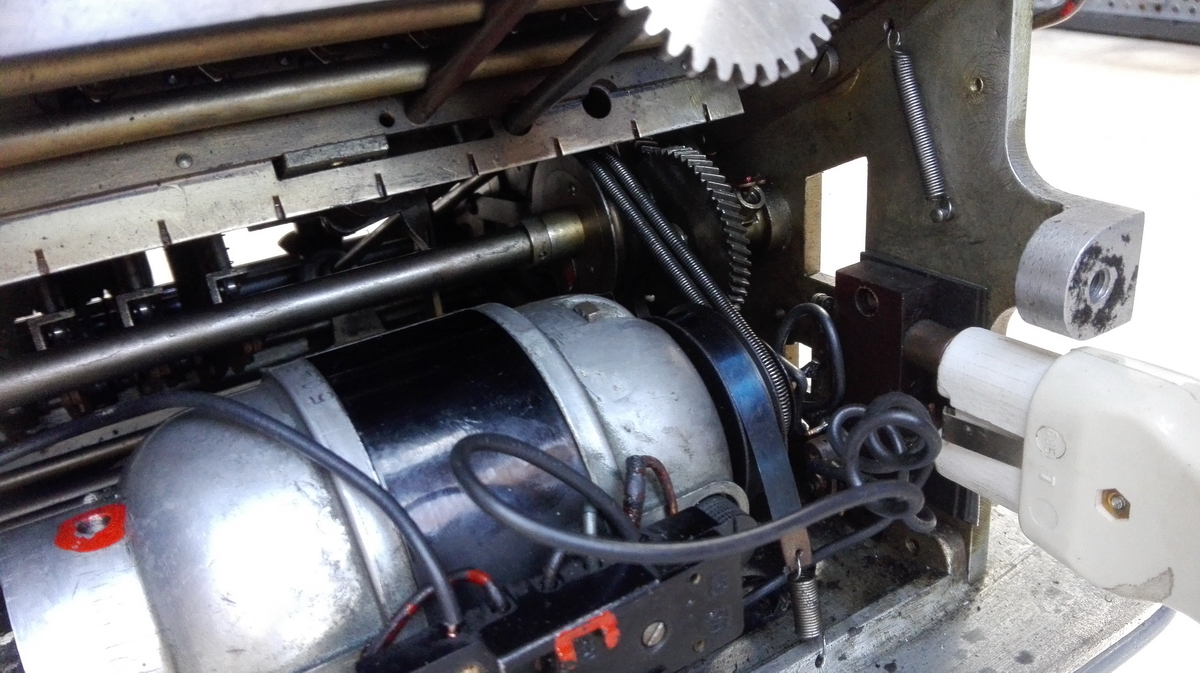
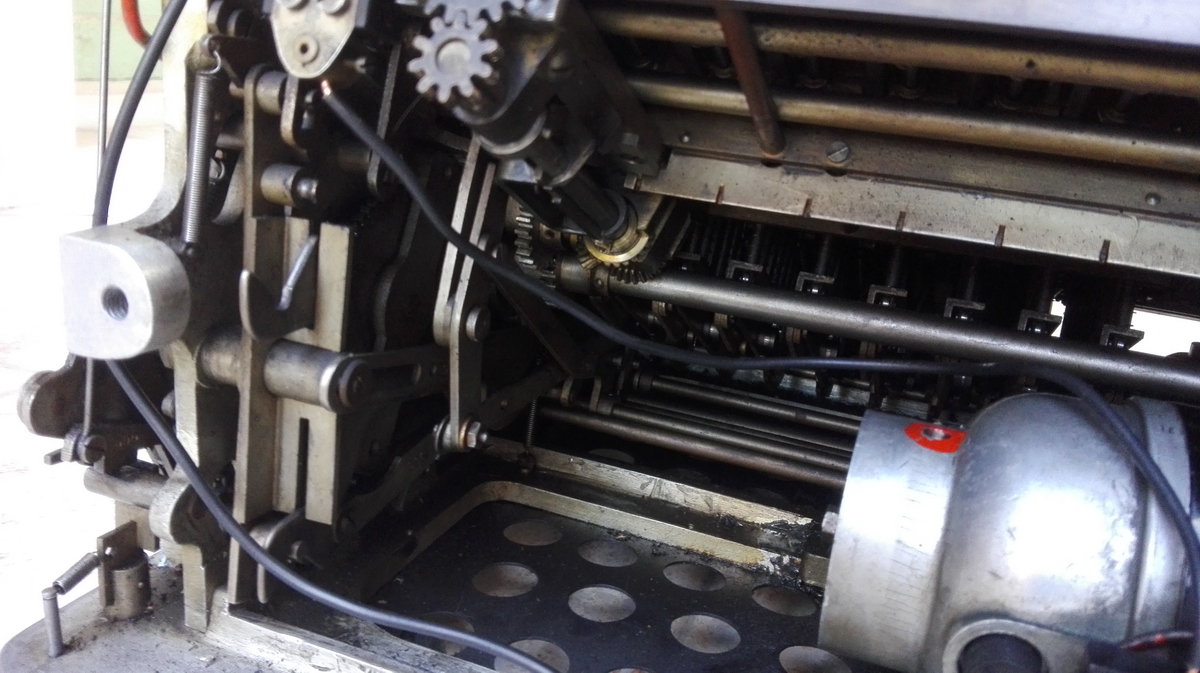
Serial number:
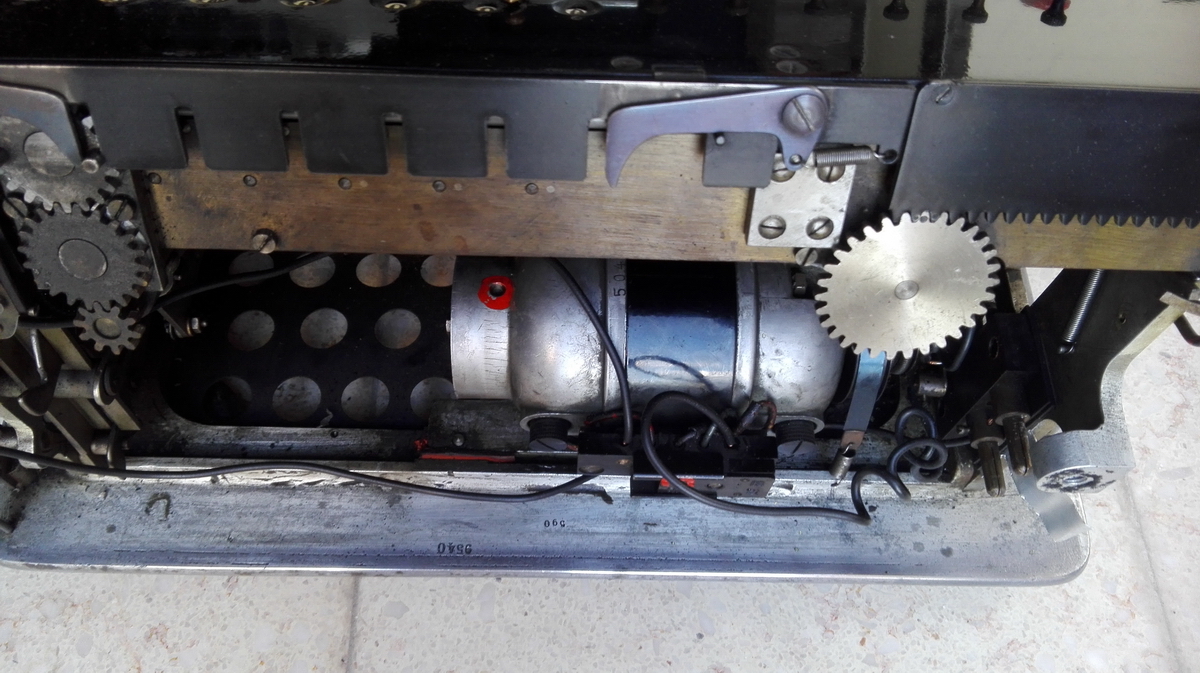
A final repair could only be made after I obtained another Archimedes of this vintage, and realize that the hinging handhold for clearing wasn't a clever idea, but that the lever broke. It is supposed to have a pin at the bottom, which pushes a lever that unocks the carriage so it can be shifted left and rigth by hand. And sure enough, the part that broke off emerged from deep within the carriage. I drilled the lever and the pin, inserted a 4mm threaded rod and reassembled with loctite (also affectionately called "liquid magic" by yours truly).
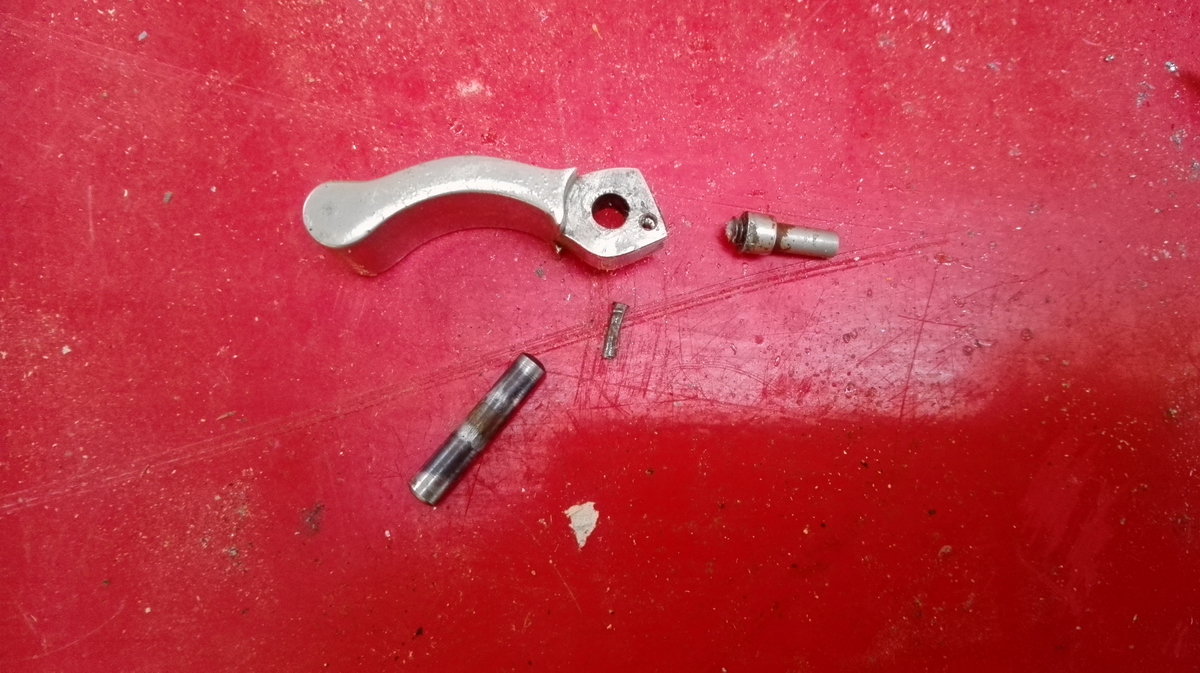
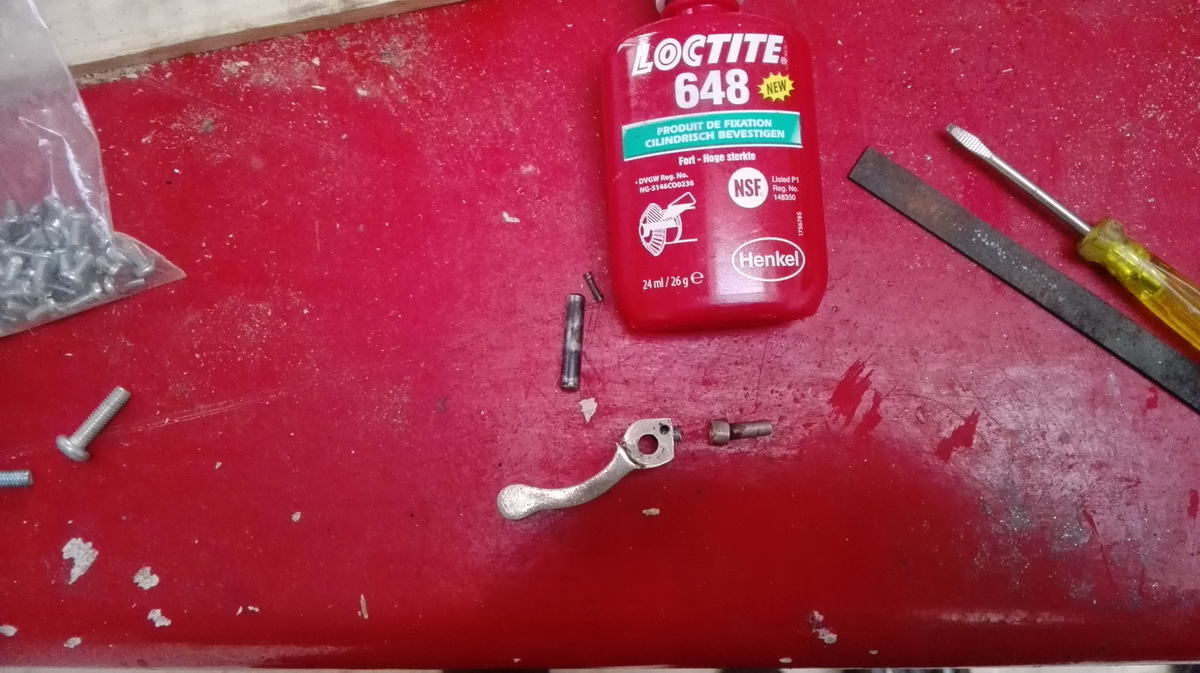
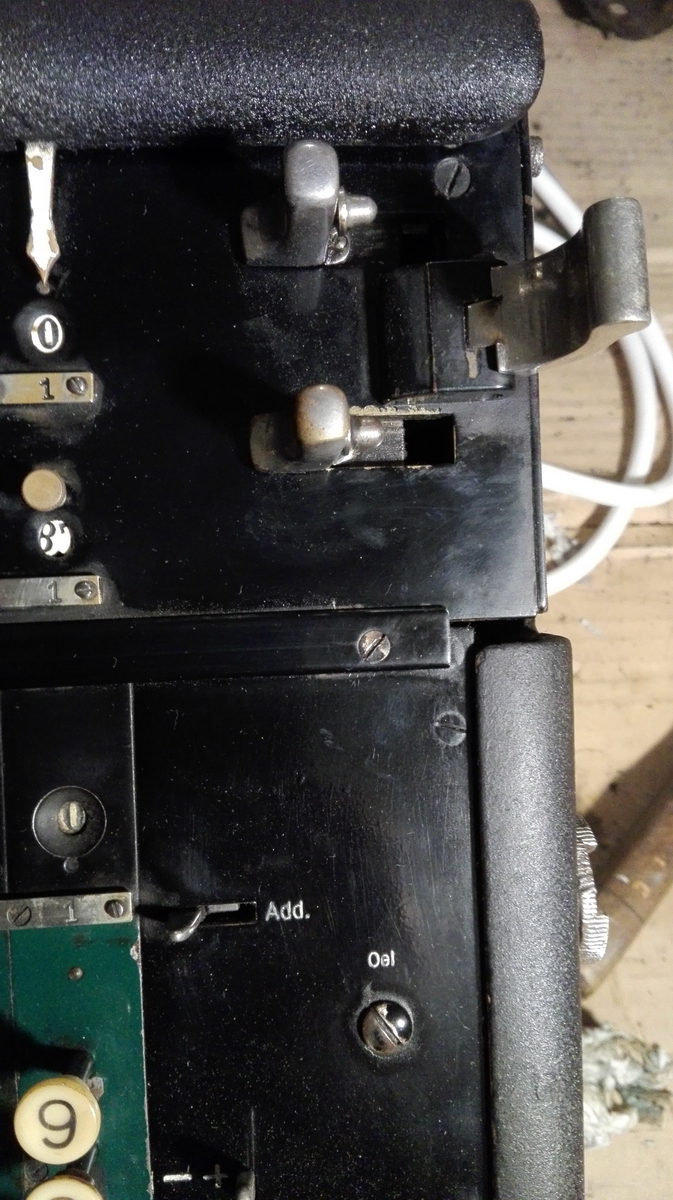 Finally, a portrait of the finished machine.
Finally, a portrait of the finished machine.
